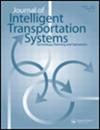Traffic-sensitive speed advisory system based on Lagrangian traffic indicators
IF 2.8
3区 工程技术
Q3 TRANSPORTATION
Journal of Intelligent Transportation Systems
Pub Date : 2024-11-01
DOI:10.1080/15472450.2023.2236549
引用次数: 0
Abstract
Can we elaborate a traffic-sensitive eco-driving or GLOSA (Green Light Optimal Speed Advice) strategy with a frugal amount of data when approaching an intersection? Here is the purpose of this work, which aims to adapt a traffic-theory-based estimation of the expected queue-length within mixed traffic (Connected and non-Connected Vehicles) in the vicinity of a signalized intersection. While the expected queue-length methodology was developed recently and fits natively with Eulerian traffic indicators resulting from loop sensors or cameras, this paper adapts such a methodology to Lagrangian indicators as the traces produced by any Connected Vehicle, including Floating Car or Probe Data. The main interest of the methodology lies in the frugal amount of data and expenses required to perform the traffic-sensitive speed-advisory at any connected road intersection. The full methodology is developed to extend the SPAT messages broadcast to end-users and take advantage of the Cooperative Awareness Messages (CAM) acting as GPS traces for Connected Vehicles. Contrary to Eulerian-based indicators, no supplementary and costly investment is required to collect the input data and compute the queue-length estimation. However, applying strategies based on Lagrangian indicators will affect the direct traffic observation through these indicators. Therefore, it requires to develop an assessment and predictive framework to estimate the traffic conditions. The performance of the introduced methodology is compared to alternative methods, among other Eulerian-based methods. It results from the analysis that the introduced approach performs almost as well as the ones based on exhaustive, but costly data collections.
基于拉格朗日交通指标的交通敏感速度咨询系统
在接近十字路口时,我们能否设计一种对交通敏感的生态驾驶或GLOSA(绿灯最佳速度建议)策略?这是本研究的目的,其目的是在信号交叉口附近的混合交通(联网和非联网车辆)中采用基于交通理论的预期排队长度估计。虽然期望队列长度方法是最近发展起来的,并且适合于由环路传感器或摄像头产生的欧拉交通指标,但本文将这种方法应用于拉格朗日指标,即任何联网车辆(包括浮动汽车或探针数据)产生的轨迹。该方法的主要兴趣在于,在任何相连的十字路口执行交通敏感的速度咨询所需的数据和费用很少。开发了完整的方法,将spv消息广播扩展到最终用户,并利用协同感知消息(CAM)作为联网车辆的GPS跟踪。与基于欧拉的指标相反,不需要额外和昂贵的投资来收集输入数据并计算队列长度估计。然而,采用基于拉格朗日指标的策略会影响通过这些指标直接观察交通。因此,需要开发一个评估和预测框架来估计交通状况。介绍的方法的性能比较替代方法,在其他欧拉为基础的方法。分析结果表明,所引入的方法的性能几乎与基于详尽但昂贵的数据收集的方法一样好。
本文章由计算机程序翻译,如有差异,请以英文原文为准。
求助全文
约1分钟内获得全文
求助全文
来源期刊
CiteScore
8.80
自引率
19.40%
发文量
51
审稿时长
15 months
期刊介绍:
The Journal of Intelligent Transportation Systems is devoted to scholarly research on the development, planning, management, operation and evaluation of intelligent transportation systems. Intelligent transportation systems are innovative solutions that address contemporary transportation problems. They are characterized by information, dynamic feedback and automation that allow people and goods to move efficiently. They encompass the full scope of information technologies used in transportation, including control, computation and communication, as well as the algorithms, databases, models and human interfaces. The emergence of these technologies as a new pathway for transportation is relatively new.
The Journal of Intelligent Transportation Systems is especially interested in research that leads to improved planning and operation of the transportation system through the application of new technologies. The journal is particularly interested in research that adds to the scientific understanding of the impacts that intelligent transportation systems can have on accessibility, congestion, pollution, safety, security, noise, and energy and resource consumption.
The journal is inter-disciplinary, and accepts work from fields of engineering, economics, planning, policy, business and management, as well as any other disciplines that contribute to the scientific understanding of intelligent transportation systems. The journal is also multi-modal, and accepts work on intelligent transportation for all forms of ground, air and water transportation. Example topics include the role of information systems in transportation, traffic flow and control, vehicle control, routing and scheduling, traveler response to dynamic information, planning for ITS innovations, evaluations of ITS field operational tests, ITS deployment experiences, automated highway systems, vehicle control systems, diffusion of ITS, and tools/software for analysis of ITS.

 求助内容:
求助内容: 应助结果提醒方式:
应助结果提醒方式:


